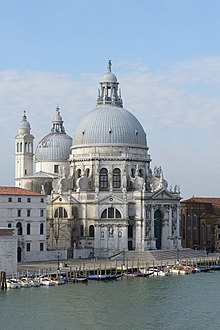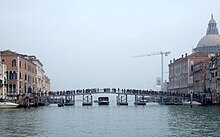Santa Maria della Salute
Santa Maria della Salute is a baroque church in the Dorsoduro sestiere in Venice at the entrance to the Grand Canal . It is one of the two votive churches in Venice that were built on the occasion of a plague epidemic in the city.
history
On October 22nd, 1630, the Doge Nicolò Contarini vowed a church to the Madonna , asking for an end to the plague that had raged in the city since 1630 and in which the city lost around 46,000 inhabitants (a third of its population). The church was to be erected in a prominent location on the Bacino di San Marco opposite the Doge's Palace . The Venetian Baldassare Longhena , a student of Scamozzi , emerged as the winner of the competition, although the Senate would have preferred to hire a Roman architect.
With the construction of the church, a fundamental urban reorganization of this area was tackled, which should shape the image of Venice, recorded in countless vedute from the 17th to the 19th century, to this day. The old buildings, the monastery and the church of San Trinità were demolished to make way for the church, the new building of the customs station and the convent building of the Somaskans who had to look after the church. These buildings are essential components of a unique urban ensemble around the Bacino. They are the result of careful planning by the Senate and the Venetian building authorities, who were able to fall back on centuries-old knowledge of urban architecture and urban staging.
Longhena worked intermittently throughout his life to build the church, which was not consecrated until 1687 , five years after his death.
In 1921 the church received the honorary title of papal minor basilica .
architecture
The plan of the then 33-year-old architect Baldassare Longhena for the church to be built was revolutionary. The exterior view, with its eight-sided floor plan, two domes and two campanili, also completely clad in marble, should be particularly impressive. With the Salute Church, Longhena created a clear alternative to the Roman Baroque by placing particular emphasis on the multilayered effects of light and shadow . Light has always been of paramount importance in Venetian architecture.
The “Salute” is an octagonal central building with the main facade facing the Grand Canal. The floor plan and the room arrangement take up early medieval and ancient models such as B. San Vitale in Ravenna or the Aachen Palatinate Church : The center is an octagonal room, which is accompanied by a set of six side altars. Like that of San Marco, the floor is provided with elaborate, but large and simple marble decorations.
The windows of the two exedra brightly illuminate the chancel, together with the high windows of another, smaller dome over the presbytery. The portal, to which a representative fifteen-step staircase alludes to Solomon's temple and the fifteen rosary mysteries, is formed by a triumphal arch facade. A special feature of the external architecture are the huge volutes , which seem to support the high windowed drum of the dome, but only have a decorative and pathetic function and serve as a base for the many figures of saints.
Longhena had major technical problems to cope with when building the domed church. More than 10,000 oak piles were used to secure the building site (The Salute Church rests on 1,106,657 trunks, each four meters long, construction time 2.2 years; according to Honor, Hugh: Venice. Munich 1977, p. 209 it was 1,156 .627 wooden posts). In order to reduce the weight of the huge dome as much as possible, Longhena constructed a light, double-shell dome made of wood, which was then plastered. The material used in the construction of the church is Istrian stone, as well as the light bricks popular in Venice, which are covered with a layer of powdered marble (marmorino) .
On the larger dome is the Immaculate with twelve stars from the Revelation of John (Jn 12: 1), on the smaller one a figure of Saint Mark .
Above the entrance portal are the Sybilles of Cumae and Erythrai .
Furnishing
The use of white plaster and gray stone makes the church furnishings look rather sober. It draws its splendor from a precious marble floor with inlay work and from the splendid altars in the chapels that adjoin the area around the central room. The sculptures on the high altar in the presbytery are reminiscent of the plague: the allegorical figure of Venezia kneels in front of the Madonna and Child , while the plague, in the form of an ugly old woman, is chased away by a putto . Integrated into the altar is an image of Mary of Byzantine origin that the Venetians regard as miraculous.
In the church there are paintings by Tintoretto , Salviati and various other artists, six paintings by Titian , which were housed there after the dissolution of the Santo Spirito monastery in Isola in the 17th century. One of these pictures was taken on the occasion of the plague epidemic of 1510, which Giorgione fell victim to, and is now in the sacristy of the church. It shows the patron saint of Venice, the evangelist Mark, together with the two doctors Cosmas and Damian as well as the plague saints Rochus and Sebastian.
Every year on November 21st, in thanks to the Madonna for salvation from the plague, a ship bridge is built for a procession from the church of Santa Maria del Giglio across the canal to the church and a festival lasting several days is celebrated with the lively participation of the residents of Venice in particular. On all feast days, services are held in uninterrupted succession from 8 a.m. until evening.
organ
The organ was built in 1782/83 by the organ builder Francesco Dacci and redesigned by the organ builder Giacomo Bazzani at the beginning of the 19th century. The instrument has 23 registers on two manuals. The upper manual (Organo primo) has 59 keys, the lower manual (Organo secondo) 30 keys. The pedal is attached and firmly coupled to the first manual, where the pedal registers are also set up. A special feature is a "Tamburo" register, which is activated by a separate pedal button.
|
|
|
|
|||||||||||||||||||||||||||||||||
opening hours
Daily 9 a.m. to 12 p.m. and 3 p.m. to 5.30 p.m.
literature
- Erich Egg , Erich Hubala and others: Reclam's art guide. Italy, Vol. 2: Upper Italy East. Stuttgart 1965.
- Elena Bassi: Architettura del Sei e Settecento a Venezia , pp. 90-102.
- Andrew Hopkins Santa Maria della Salute: architecture and ceremony in Baroque Venice. Cambridge 2000.
- Rudolf Wittkower: S. Maria della Salute: scenographic architecture and the Venetian Baroque , in: SAH 1, 1958, pp. 3–10.
- Herbert Rosendorfer : Church leaders Venice. Edition Leipzig 2008, ISBN 978-3-361-00618-8 .
- Ennio Concina, Pietro Codato, Vittorio Pavan: Churches in Venice. Hirmer Verlag, Munich 1996, ISBN 3-7774-7010-4 .
Web links
- Jan-Christoph Rößler : Santa Maria della Salute
- Museum Planet: Virtual tour of Santa Maria della Salute ( Memento from June 11, 2008 in the Internet Archive )
Coordinates: 45 ° 25 ′ 50.7 ″ N , 12 ° 20 ′ 3.9 ″ E




